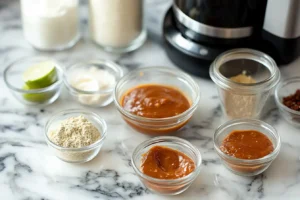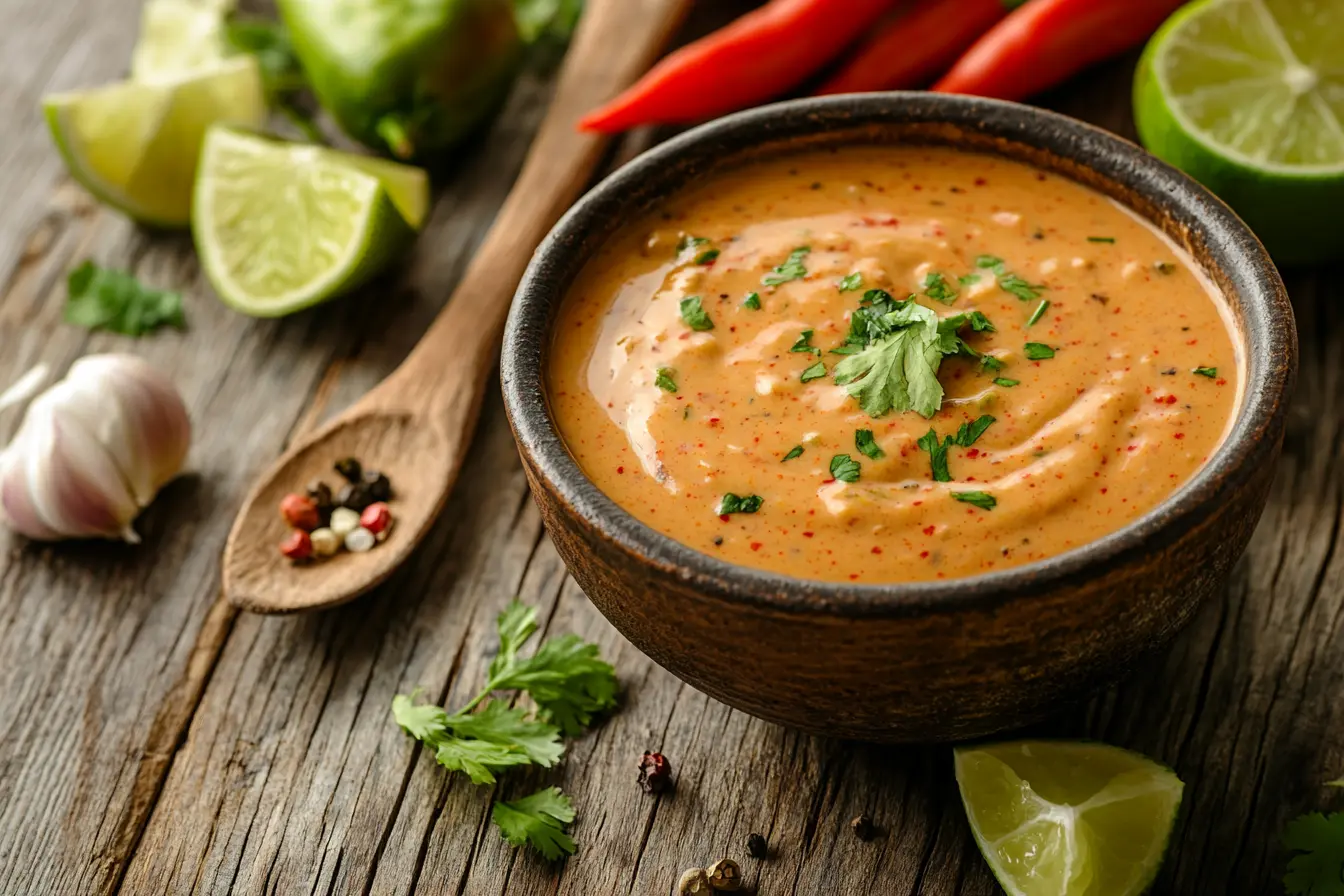Chipotle Sauce: The Ultimate Guide to Making and Using This Smoky Condiment
Chipotle sauce has become a beloved staple in kitchens worldwide. Its rich, smoky flavor and creamy texture make it the ultimate crowd-pleaser, whether you’re drizzling it over tacos, dipping your fries, or elevating a simple burger to gourmet status. In this guide, we’ll explore everything you need to know about this versatile condiment—from its origins to how to make it at home, its health benefits, and all the delicious ways to incorporate it into your meals. Whether you’re new to chipotle sauce or already a fan, you’re sure to discover something new and exciting.
What Is Chipotle Sauce?
The Origins of Chipotle Sauce
Chipotle sauce is rooted in Mexican culinary traditions. The term “chipotle” comes from the Nahuatl word chīlpōctli, which means “smoked chili.” This ancient technique of smoking jalapeño peppers not only preserved them but also enhanced their flavor, adding a distinct smokiness that sets them apart. Over time, this process inspired the creation of the creamy, spicy sauce we enjoy today, blending peppers with bold ingredients like lime juice, garlic, and spices.
Key Ingredients That Define Its Flavor
At its core, chipotle sauce combines smoked chipotle peppers in adobo sauce with a creamy base such as mayonnaise, sour cream, or Greek yogurt. The result is a balance of smoky, spicy, and tangy flavors. Ingredients like lime juice, garlic, and sometimes a touch of honey or sugar add brightness and complexity. This sauce strikes the perfect balance between heat and creaminess, making it irresistible.
Why It’s a Popular Condiment in Mexican Cuisine
In Mexican cuisine, chipotle sauce has become a must-have for its versatility. It’s often used to add smoky depth to tacos, enchiladas, and burritos or as a dipping sauce for tortilla chips. Its creamy texture also works beautifully to cut through spicy or rich dishes, creating a harmonious balance of flavors.
The Versatility of Chipotle Sauce
Uses in Everyday Meals
Chipotle sauce isn’t limited to Mexican food—it has found its way into countless dishes worldwide! Imagine using it as a spread for sandwiches, a dressing for salads, or a topping for baked potatoes. Need a quick flavor boost? Stir it into soups, stews, or even pasta dishes for an instant upgrade.
Popularity Across Various Cuisines
It’s not just a Mexican condiment anymore! This smoky sauce has gained popularity in everything from barbecue spreads to vegan Buddha bowls. Whether you’re pairing it with grilled vegetables, marinating chicken, or drizzling it over roasted sweet potatoes, it has a way of bringing dishes to life.
(Pro Tip: Curious about the health benefits of peppers? Check out this insightful article on the health benefits of peppers to learn more.)
How to Make Chipotle Sauce at Home
Homemade Chipotle Sauce Recipe
Making chipotle sauce at home is surprisingly easy, and it tastes so much better than anything store-bought! Plus, you have the flexibility to tweak the flavors to match your preferences. Below is a foolproof recipe that delivers a smoky, creamy, and utterly irresistible sauce.
Ingredients Needed for the Perfect Chipotle Sauce
To whip up your own chipotle sauce, you’ll need:
- 2–3 chipotle peppers in adobo sauce
- ½ cup of mayonnaise (or Greek yogurt for a lighter option)
- 1 tablespoon of freshly squeezed lime juice
- 1 clove of minced garlic
- ½ teaspoon of smoked paprika (optional, for an extra smoky kick)
- Salt and pepper to taste
Step-by-Step Instructions
 Preparing the Base
Preparing the Base
Start by combining the mayonnaise (or your chosen creamy base) with lime juice in a blender or food processor. This forms the foundation of the sauce, ensuring a smooth and creamy texture.
Adding the Chipotle Peppers
Next, add the chipotle peppers in adobo sauce. Depending on your heat tolerance, you can use fewer peppers for a milder flavor or go bold with three peppers for extra spice. Blend the mixture until smooth.
Balancing Flavors with Seasonings
Finally, toss in the minced garlic, smoked paprika (if using), and a pinch of salt and pepper. Blend everything again until the sauce is silky and evenly mixed. Taste and adjust seasonings as needed.
(Pro Tip: For a vegan version, substitute the mayonnaise with vegan mayo or cashew cream!)
Tips for Customizing Chipotle Sauce
Adjusting the Spice Level
One of the best parts about making your own chipotle sauce is controlling the heat. If the sauce feels too spicy, add more of the creamy base or a teaspoon of honey to mellow out the heat. If it’s not spicy enough, toss in an extra chipotle pepper or a pinch of cayenne.
Variations: Creamy, Vegan, or Extra Spicy Options
For a creamier version, mix in a dollop of sour cream or heavy cream. Want to keep it vegan? Use plant-based ingredients like coconut yogurt or tahini for a unique twist. And if you’re a fan of intense heat, try adding a splash of chili oil or some diced fresh jalapeños for a fiery kick.
Nutritional Information and Health Benefits
Chipotle Sauce Nutrition Facts
Calories and Macros per Serving
When made with a creamy base like mayonnaise or Greek yogurt, chipotle sauce provides a rich source of flavor without overwhelming your calorie count. On average, a two-tablespoon serving contains:
- Calories: ~80–100 (depending on the base)
- Fat: 8 grams (mostly healthy fats from the mayo or yogurt)
- Protein: ~1 gram
- Carbohydrates: Less than 2 grams
Key Vitamins and Minerals Found in Chipotle Sauce
Surprisingly, chipotle peppers are loaded with nutrients! They’re a natural source of vitamins A and C, which support immune health and skin vitality. The lime juice and garlic in the sauce also add trace amounts of antioxidants and minerals like potassium.
Health Benefits of Chipotle Sauce
Antioxidants from Chipotle Peppers
The smoky chipotle peppers used in this sauce are rich in antioxidants, particularly capsaicin, which is known for its anti-inflammatory properties. Capsaicin not only adds that signature heat but may also help combat oxidative stress in the body.
Role of Spices in Digestion and Metabolism
The spices in chipotle sauce—from garlic to paprika—offer more than just flavor. Garlic is widely recognized for its potential to support heart health, while the heat from chipotle peppers can give your metabolism a gentle boost, helping the body burn calories more efficiently.
Low-Calorie and Keto-Friendly Condiment
If you’re watching your carbs or trying to stick to a ketogenic diet, chipotle sauce is a great choice. By swapping out mayonnaise for Greek yogurt or vegan alternatives, you can easily create a low-fat version without sacrificing flavor.
Considerations for Dietary Restrictions
Is Chipotle Sauce Vegan or Gluten-Free?
Yes, it can be! The base ingredient is key. Traditional recipes use mayonnaise, which contains eggs, but swapping it for vegan mayo creates a plant-based alternative. Similarly, chipotle sauce is naturally gluten-free as long as you check that your chipotle peppers and seasonings are free from gluten-containing additives.
Substitutions for Common Allergens
For those with dietary restrictions, there are plenty of substitutions to enjoy this smoky condiment:
- Egg-free option: Use vegan mayo or cashew cream.
- Dairy-free option: Substitute Greek yogurt with coconut yogurt or tahini.
- Low-sodium: Opt for no-salt-added adobo sauce and season with herbs instead of salt.
Store-Bought vs. Homemade Chipotle Sauce
Comparing Quality and Taste
What Sets Homemade Apart from Store-Bought?
Homemade chipotle sauce allows you to customize the flavor, texture, and spice level to suit your taste buds. Store-bought versions, while convenient, often include preservatives, stabilizers, or artificial ingredients that can alter the authentic smoky flavor. When you make it yourself, the sauce has a fresher taste and fewer unwanted additives.
Common Ingredients in Store-Bought Chipotle Sauces
Store-bought brands typically use a combination of chipotle peppers, vinegar, sugar, and emulsifiers. Many also contain added thickeners or oils to ensure a longer shelf life. While these are fine for occasional use, they lack the vibrancy and richness of a freshly made chipotle sauce.
Best Store-Bought Chipotle Sauce Brands
What to Look For When Buying Chipotle Sauce
If you decide to buy chipotle sauce, check the label for key factors like:
- Minimal Ingredients: Look for sauces made with natural ingredients.
- No Artificial Preservatives: Avoid those with unnecessary additives.
- Specialty Options: Organic, vegan, or low-sodium options are widely available for those with dietary preferences.
Recommended Brands for Specific Needs
- Organic & Clean Options: Brands like Primal Kitchen offer organic, keto-friendly chipotle sauces.
- Budget-Friendly Choice: La Costeña’s chipotle sauce is affordable and flavorful.
- Vegan-Friendly Option: Sir Kensington’s Chipotle Vegan Mayo offers a plant-based twist.
Cost Analysis: Is Homemade Cheaper?
Cost Comparison of Ingredients vs. Ready-Made Sauces
Making chipotle sauce at home can often save you money, especially if you already have staples like mayonnaise, lime, and garlic in your pantry. A can of chipotle peppers in adobo sauce typically costs less than $2 and can make multiple batches of sauce.
In contrast, store-bought chipotle sauces range from $5–$10 per bottle, depending on the brand. Over time, the savings from making your own sauce can add up, particularly if you’re using it often.
Best Dishes to Pair with Chipotle Sauce
Using Chipotle Sauce as a Dipping Sauce
Pairing with Fries, Chips, and Nuggets
Let’s face it: few things are as satisfying as dipping crispy fries or chicken nuggets into a smoky, creamy chipotle sauce. Its bold flavor complements fried foods perfectly, creating a harmony of textures and tastes. Whether you’re hosting a game night or simply snacking, chipotle sauce instantly upgrades classic dips like ketchup or ranch. Tortilla chips, on the other hand, become irresistible when paired with this tangy, spicy condiment.
Elevating Appetizers with Chipotle Dipping Sauce
Chipotle sauce isn’t just for fried treats—it also shines when paired with appetizers like grilled shrimp skewers, veggie platters, or stuffed jalapeños. In fact, it adds an exciting kick that makes even the simplest appetizers feel gourmet. The smokiness of the sauce works wonders with charred vegetables or roasted potatoes, while its creaminess balances out spicy or salty snacks. So, whether you’re prepping for a casual get-together or a festive celebration, this sauce fits right in.
Chipotle Sauce in Main Dishes
Burgers, Tacos, and Burritos with a Smoky Twist
 A juicy burger topped with chipotle sauce—it doesn’t get better than that! The sauce adds a rich, smoky flavor that pairs beautifully with beef, chicken, or veggie patties. But wait, there’s more! Drizzle it over tacos or burritos, and you’ve got yourself a meal that’s bursting with flavor. The tanginess of lime and the heat from the chipotle peppers amplify the taste of seasoned meats, fresh veggies, and tortillas.
A juicy burger topped with chipotle sauce—it doesn’t get better than that! The sauce adds a rich, smoky flavor that pairs beautifully with beef, chicken, or veggie patties. But wait, there’s more! Drizzle it over tacos or burritos, and you’ve got yourself a meal that’s bursting with flavor. The tanginess of lime and the heat from the chipotle peppers amplify the taste of seasoned meats, fresh veggies, and tortillas.
Marinating Meats and Seafood
Here’s a pro tip: use chipotle sauce as a marinade! The combination of creaminess, spice, and acidity tenderizes chicken, pork, or even shrimp while infusing them with a smoky depth. Grill or roast them, and you’ll end up with a dish that feels like it’s straight from a high-end restaurant.
Creative Ideas for Using Chipotle Sauce
Salad Dressings and Pasta Sauces
Who says chipotle sauce can’t be a salad dressing? Mix it with olive oil or yogurt for a zesty twist on traditional dressings. It’s fantastic drizzled over a hearty taco salad or even a simple bowl of greens with avocado and cherry tomatoes. Meanwhile, pasta lovers can stir it into their favorite dishes, such as mac and cheese or creamy pasta sauces, to add an unexpected depth of flavor.
Adding Spice to Soups and Stews
Sometimes, soups and stews need just a little something extra—and chipotle sauce delivers! A spoonful swirled into a bowl of tomato soup or chili transforms the dish into something memorable. Its smoky flavor enhances broths while its creamy texture thickens the base slightly, creating a comforting, well-rounded bite.
Storing and Preserving Chipotle Sauce
Best Practices for Storing Chipotle Sauce
Refrigeration Tips for Optimal Freshness
Once you’ve made your delicious chipotle sauce, proper storage is essential to keep it fresh and flavorful. Always store the sauce in an airtight container, such as a glass jar or a resealable food-safe container. Place it in the refrigerator immediately after making it to prevent spoilage. Ideally, the temperature should remain below 40°F (4°C) to ensure the sauce stays safe to eat. Not only does refrigeration preserve the taste, but it also helps retain the creamy texture.
How Long Chipotle Sauce Stays Good
Homemade chipotle sauce generally lasts about 7–10 days in the refrigerator if stored correctly. However, it’s a good idea to check the sauce for signs of spoilage, such as an off smell, discoloration, or a sour taste, before using it. Freshness can also depend on the base you use—sauces made with yogurt or sour cream may not last as long as those made with mayonnaise.
Freezing Chipotle Sauce for Long-Term Use
How to Properly Freeze and Thaw Chipotle Sauce
If you’re not planning to use all the sauce within a week, freezing it is a fantastic option. To freeze chipotle sauce, transfer it into a freezer-safe container or portion it into ice cube trays for easy use. This way, you can defrost just the amount you need later. Before sealing the container, make sure to leave a little room for expansion, as the sauce may expand slightly as it freezes.
When you’re ready to use the frozen sauce, simply transfer it to the refrigerator to thaw overnight. Avoid microwaving the frozen sauce, as this can alter its texture and cause the creamy base to separate. After thawing, give it a good stir to restore its smooth consistency.
Ensuring Quality After Freezing
While freezing preserves chipotle sauce for up to 3 months, it’s worth noting that the texture may slightly change depending on the base used. For example, mayonnaise-based sauces tend to maintain their consistency better than yogurt-based ones. However, the flavor remains intact, making it a convenient solution for batch preparation.
Avoiding Common Storage Mistakes
Preventing Contamination
To extend the shelf life of your chipotle sauce, avoid dipping utensils directly into the jar, as this can introduce bacteria. Instead, use a clean spoon to scoop out what you need, and promptly reseal the container after each use.
Recognizing Signs of Spoilage
Even when stored correctly, it’s crucial to know when your chipotle sauce has gone bad. Spoilage signs include a sour or rancid smell, unusual texture changes like clumping or separation, or visible mold growth. If you spot any of these, it’s best to discard the sauce immediately to avoid potential foodborne illnesses.
FAQs About Chipotle Sauce
What is chipotle sauce made of?
Chipotle sauce is typically made with chipotle peppers in adobo sauce, a creamy base such as mayonnaise or Greek yogurt, lime juice, garlic, and seasonings like smoked paprika. These ingredients come together to create a smoky, tangy, and spicy sauce that’s perfect for countless dishes.
Can I make chipotle sauce without mayonnaise?
Absolutely! You can replace mayonnaise with alternatives like Greek yogurt, sour cream, or even vegan options like cashew cream or coconut yogurt. Each alternative will slightly alter the flavor and texture but still deliver that signature chipotle smokiness.
Is chipotle sauce spicy?
Yes, chipotle sauce carries a spicy kick, thanks to the smoked chipotle peppers. However, the spice level can be adjusted to suit your taste. Adding more creamy base or a splash of honey can mellow the heat, while extra peppers will increase the intensity.
What’s the difference between chipotle sauce and chipotle mayo?
While both contain chipotle peppers, chipotle mayo is a specific type of chipotle sauce made exclusively with mayonnaise as the base. In contrast, chipotle sauce may include other creamy bases like yogurt or sour cream, offering a more versatile flavor profile.
How can I make chipotle sauce healthier?
To make a healthier version, swap mayonnaise for Greek yogurt or avocado, use low-sodium seasonings, and skip added sugars. These changes maintain the smoky, spicy taste while lowering calories and improving nutritional content.
What are the best substitutes for chipotle peppers?
If you can’t find chipotle peppers, you can use smoked paprika for a similar smoky flavor. Alternatively, dried ancho chilies or canned roasted red peppers combined with a touch of hot sauce work well as substitutes.
My chipotle sauce is too spicy – how can I fix it?
If your sauce is spicier than expected, try adding more of the creamy base, like yogurt or mayonnaise, to dilute the heat. You can also add a teaspoon of honey or a splash of milk to balance out the spice without altering the overall flavor.
Why is my sauce too thin or thick?
If your sauce turns out too thin, try blending in an extra spoonful of your base ingredient (e.g., mayo or yogurt) to thicken it. On the flip side, if it’s too thick, a small splash of lime juice or water can help achieve the desired consistency without compromising the flavor.

